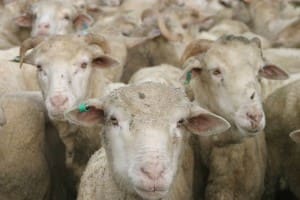NEW South Wales sheep and goat producers were today warned their compliance under the National Livestock Identification System will be checked at state saleyards and abattoirs over the next six months.
The campaign, code-named ‘Operation Mary,’ by the NSW Department of Primary Industries and Local Land Services aimed to increase producer understanding and compliance with the NLIS for sheep and goats.
Compliance will be checked at NSW sheep and goat saleyards by NSW DPI and LLS staff, and NSW Police Rural Crime Investigators.
Operational staff will ensure that all sheep are tagged and that National Vendor Declarations are completed accurately, especially with the recording of ‘other PICs’ on NVDs for non-vendor bred lots.
Sheep Central was told today the average NLIS compliance in NSW saleyards is running at about 90 percent, but in 2014 all states agreed to achieve 98pc short-run traceability and 95pc long-run traceability through ongoing monitoring, with business rules reviewed to ensure performance standards are met.
Improvements in NSW compliance needed
NSW DPI director of compliance biosecurity and food safety, Peter Day, said there is strong support in NSW for the current mob-based traceability system for NLIS for sheep and goats. However, improvements in compliance rates are needed.
“NSW has one of the best livestock identification systems in the world for tracing our livestock from the paddock to plate through the NLIS.
“Producers have obligations, roles and responsibilities at the beginning of the supply chain which sets the foundation for traceability,” Mr Day said.
“Saleyards and agents have a responsibility to ensure that the NLIS operates well in their saleyard and that their clients are NLIS compliant.
“It enhances our ability to respond quickly to a major food safety or disease incident, and helps to ensure access to valuable export markets are maintained,” Mr Day said.
Local Land Services executive manager Tim Ferraro said Operation Mary aimed to ensure sheep and goats are correctly tagged and that National Vendor Declarations accompanying each mob are accurately completed.
“We know that producers in NSW are keen to maintain the current mob based system for NLIS compliance for sheep and goats.
“Operation Mary will deliver strong data around the current levels of compliance and allow us to focus our work with the industry to support increasing levels of compliance into the future,” Mr Ferraro said.
“This is one way Local Land Services is working with our ratepayers and other land managers to ensure bio-secure, profitable, productive and sustainable primary industries in NSW.”
NSW not the only state with compliance issues
In August last year, then NSW Farmers president Derek Schoen claimed National Vendor Declaration accuracy had improved to around 98pc in some saleyards in NSW during compliance activity conducted in 2013.
But a 2014 study in Victoria of sheep in saleyard and direct consignments from NSW, Victorian and Tasmanian producers showed that for 41pc of all tags collected there was no record of the PIC on the accompanying paperwork; for 35pc of PICs listed on paperwork, there was no record of these PICs being on tags, and 25pc of PICs hand-written on NVDs (known as ‘additional PICs) had been incorrectly transcribed by the vendor. Saleyards involved Ballarat, Horsham and Bendigo in Victoria; Corowa, Dubbo, Cooma, Wagga Wagga, Goulburn, Griffith and Carcoar in NSW, and; Quoiba and Bridgewater in Tasmania.
A 2015 study in Victoria involving about 15,000 sheep from Victorian, NSW and South Australian producers found that for 44pc of all tags collected, there was no record of the PIC on the accompanying paperwork; for 41pc of PICs listed on paperwork, there was no record of these PICs being on tags and; 15pc of PICs hand-written on NVDs (known as ‘additional PICs) had been incorrectly transcribed by the vendor.
About 55pc of the sheep in the 2015 study originated from saleyard consignments and 45pc from direct consignments. Saleyards involved included Wagga Wagga, Dubbo and Forbes in NSW; Ballarat, Bendigo, Swan Hill, Bairnsdale, Hamilton, Warragul and Ouyen in Victoria, and; Naracoorte and Mt Gambier in South Australia. Of the PICs sourced from tags 66pc were from Victoria, 18pc were from NSW, 14pc came from SA, and 1pc were from Tasmania and Queensland. Of the consignment PICs sourced from paperwork 55pc were from Victoria, 32pc were from NSW and 13pc came from South Australia.


If growers don’t list the Property Identity Code of the sheep they are selling they have the option of applying post-breeder pink tags with their PIC on them, or of course, reading each tag and listing the PIC on the vendor declaration.
So Shane what’s the alternative ?
The compliance with the NLIS is one of biggest jokes in the meat industry. It is like recreational fishing. A catch and release policy — with the statement that no producers were harmed during the enforcement of this rule.